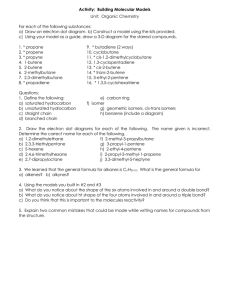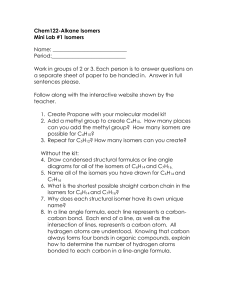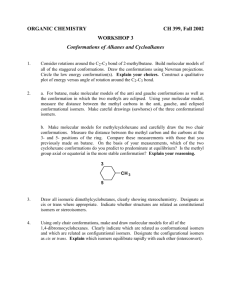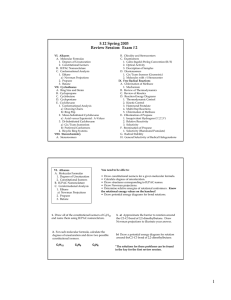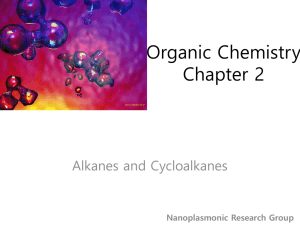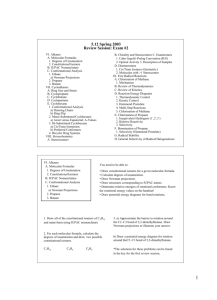review sheet with practice problems
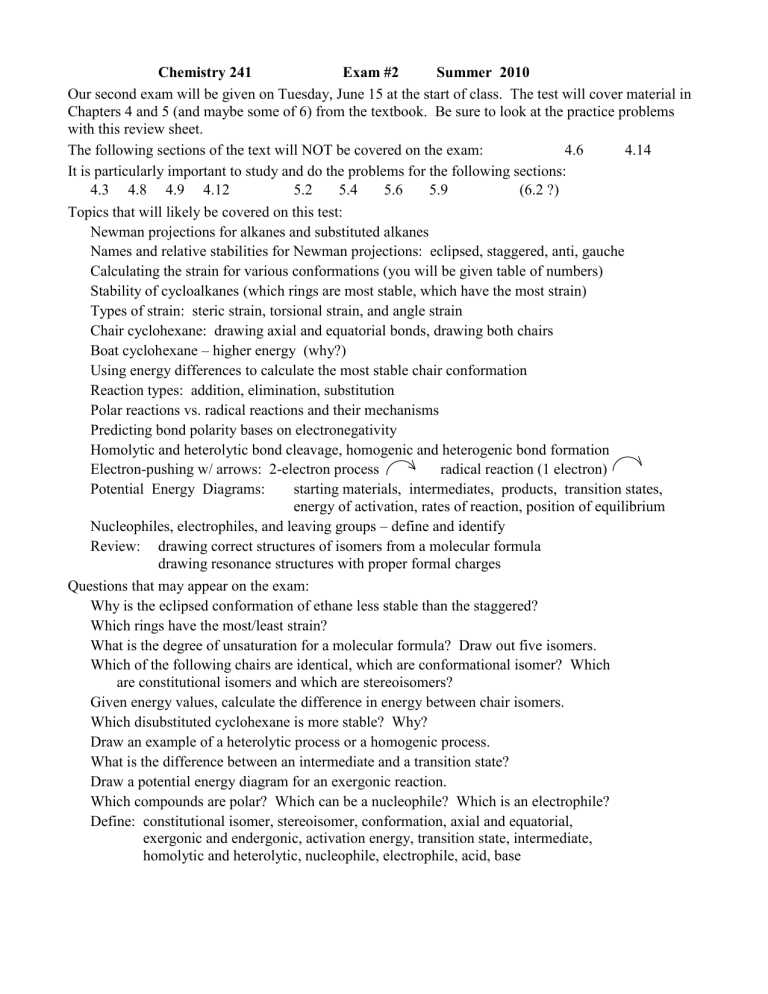
Chemistry 241 Exam #2 Summer 2010
Our second exam will be given on Tuesday, June 15 at the start of class. The test will cover material in
Chapters 4 and 5 (and maybe some of 6) from the textbook. Be sure to look at the practice problems with this review sheet.
The following sections of the text will NOT be covered on the exam: 4.6 4.14
It is particularly important to study and do the problems for the following sections:
4.3 4.8 4.9 4.12 5.2 5.4 5.6 5.9 (6.2 ?)
Topics that will likely be covered on this test:
Newman projections for alkanes and substituted alkanes
Names and relative stabilities for Newman projections: eclipsed, staggered, anti, gauche
Calculating the strain for various conformations (you will be given table of numbers)
Stability of cycloalkanes (which rings are most stable, which have the most strain)
Types of strain: steric strain, torsional strain, and angle strain
Chair cyclohexane: drawing axial and equatorial bonds, drawing both chairs
Boat cyclohexane – higher energy (why?)
Using energy differences to calculate the most stable chair conformation
Reaction types: addition, elimination, substitution
Polar reactions vs. radical reactions and their mechanisms
Predicting bond polarity bases on electronegativity
Homolytic and heterolytic bond cleavage, homogenic and heterogenic bond formation
Electron-pushing w/ arrows: 2-electron process radical reaction (1 electron)
Potential Energy Diagrams: starting materials, intermediates, products, transition states, energy of activation, rates of reaction, position of equilibrium
Nucleophiles, electrophiles, and leaving groups – define and identify
Review: drawing correct structures of isomers from a molecular formula drawing resonance structures with proper formal charges
Questions that may appear on the exam:
Why is the eclipsed conformation of ethane less stable than the staggered?
Which rings have the most/least strain?
What is the degree of unsaturation for a molecular formula? Draw out five isomers.
Which of the following chairs are identical, which are conformational isomer? Which
are constitutional isomers and which are stereoisomers?
Given energy values, calculate the difference in energy between chair isomers.
Which disubstituted cyclohexane is more stable? Why?
Draw an example of a heterolytic process or a homogenic process.
What is the difference between an intermediate and a transition state?
Draw a potential energy diagram for an exergonic reaction.
Which compounds are polar? Which can be a nucleophile? Which is an electrophile?
Define: constitutional isomer, stereoisomer, conformation, axial and equatorial, exergonic and endergonic, activation energy, transition state, intermediate, homolytic and heterolytic, nucleophile, electrophile, acid, base
Chem 241 Exam 2 Practice Problems
1.
Using skeletal structures, draw four different isomers for compounds with the formula C
5
H
10
O.
Include (and circle) a pair of stereoisomers .
2.
Compare each set of cyclohexane chair isomers, and indicate whether they are identical, flipped chair (conformational) isomers, stereoisomers, or different constitutional isomers.
NH
2
Et and
HOCH
2 and
CH
2
OH
Et
NH
2
3.
For these polar reactions, give the expected product Draw an arrow to indicate the flow of electrons.
RS +
Me
HH
C Br
H
2
O
O
+ MgBr
Me Me Et
2
O
4.
Draw cis -1,3-dimethylcyclohexane in the two possible chair conformations, and underline the most stable chair. For one chair, include all axial and equatorial bonds and atoms.
5.
Draw and label a staggered Newman projection for 3-methylhexane , looking at the C 3 - C 4 bond, then draw and label an eclipsed conformation. Circle the most stable structure.
6.
For the following reactions, give the products, based on the flow of electrons shown by the arrows.
RO
O
H
Cl
:NH
3
Br
THF
Et
2
O

